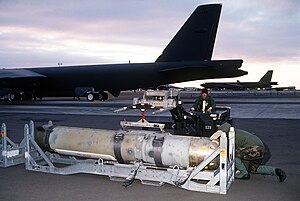| Mark 60 CAPTOR | |
|---|---|
 Mark 60 mine being loaded into a B-52 Stratofortress at Loring Air Force Base in 1989 Mark 60 mine being loaded into a B-52 Stratofortress at Loring Air Force Base in 1989 | |
| Type | Antisubmarine naval mine |
| Place of origin | United States |
| Service history | |
| In service | 1979-2001 |
| Used by | United States Navy |
| Wars | Cold War |
| Production history | |
| Designer | Goodyear Aerospace |
| Manufacturer | Goodyear Aerospace |
| Unit cost | US $113,000 (FY78) US $377,000 (FY86) |
| Produced | 1978-1986 |
| Variants | Mine Mk 66, Mk 46 Mod 5 (NEARTIP) |
| Specifications | |
| Mass | Aircraft/ship-laid:1,077 kg (2,374 lb) Submarine-laid:935 kg (2,061 lb) |
| Length | Aircraft/ship-laid:3.68 m (145 in) Submarine-laid:3.35 m (132 in) |
| Diameter | 530 mm (21 in) |
| Effective firing range | 8,000 yards (7,300 m) |
| Warhead | Mark 46 torpedo |
| Warhead weight | 44 kg (97 lb), PBXN-103 |
| Engine | Two-speed, reciprocating external combustion |
| Propellant | Otto fuel II |
| Maximum depth | 1,000 feet (300 m) |
| Maximum speed | >28 knots (52 km/h) |
| Guidance system | Active or passive/active acoustic homing, snake or circle search, reliable acoustic path (RAP) sound propagation |
| Launch platform | Aircraft, surface ship and submarines |
The Mark 60 CAPTOR (Encapsulated Torpedo) is the United States' only deep-water anti-submarine naval mine. It uses a Mark 46 torpedo contained in an aluminum shell that is anchored to the ocean floor. The mine can be placed by either aircraft, submarine or surface vessel. The torpedo, once placed, can last anywhere from weeks to months underwater. The original production contract of the CAPTOR mine was awarded to Goodyear Aerospace in 1972, and entered service in 1979. It was hoped to reduce minefield costs and used in the creation of a barrier of the "Greenland-Iceland-United Kingdom gap to interrupt Soviet submarines in the event that deterrence failed."
The mine uses Reliable Acoustic Path (RAP) sound propagation to passively identify and track the difference between hostile submarine signatures, surface vessels and friendly submarines. Once identified, the torpedo leaves its casing to destroy its target.
References
- ^ DiGiulian, Tony. "Mines of the United States of America - NavWeaps". www.navweaps.com. Retrieved 2017-04-22.
- ^ "Mk 60 Captor Mine | VP-4 Association". www.vp4association.com. 28 May 2011. Retrieved 2017-04-22.
- ^ "U.S. Naval Mines - Captor program". www.hartshorn.us. Archived from the original on 2012-01-12. Retrieved 2017-04-22.
- ^ "Naval Mines and Mining: Innovating in the Face of Benign Neglect". Center for International Maritime Security. 2016-12-20. Retrieved 2017-04-22.
External links
[REDACTED] Media related to CAPTOR mine at Wikimedia Commons
Categories: